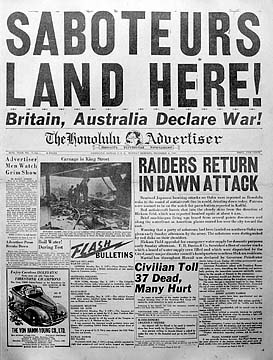


|
Historic day Shortly after the 7:55 a.m. attack on Pearl Harbor, Riley Allen, Honolulu Star-Bulletin editor, dashed to the pressroom, ordering the pressmen to "light the metal," to fire up the Linotype machines.
for Bulletin
The paper printed 250,000
12/07/41 Newspaper images
copies of 3 special editions
First draft of history Honoring heroes
Pride, sadness at Utah Memorial
War changed KuakiniBy Richard Borreca
rborreca@starbulletin.comAllen had just gotten word from Joseph Gomes, Star-Bulletin circulation manager, who was at Pearl Harbor, that planes with the rising-sun insignia were bombing the naval base.
Allen quickly assembled a staff of reporters, editors and printers to start work.
By the end of the day, Allen and his team at the Star-Bulletin would put out three special editions -- 250,000 copies of one of the most historic newspapers in American journalism.

|
Reprints of that front page are still sold in Honolulu and at Pearl Harbor.Robert Hinkley, the son of former managing editor Vern Hinkley, remembers reading the comics Sunday morning and hearing the Japanese planes come overhead and going outside and seeing the rising-sun emblem. He rushed in to tell his dad. A few minutes later, Vern Hinkley got a call from Riley Allen to "get down here. We gotta put out an extra."
His dad came home late in the afternoon and said the newsroom was "pandemonium, everybody organized" but just moving at double time.
At the time of the attack, Henry Zerbe, now a retired First Hawaiian Bank executive, was a 15-year-old newspaper carrier. He remembers getting a call asking if he wanted to sell the Star-Bulletin extra edition in Makiki.
"Everyone wanted a paper. The radio broadcast for a while, then it was shut off, so everyone wanted to know what was happening.
"All I had to do was stand on the corner and yell 'Extra!' Everybody came out," Zerbe recalls.
Later, Joseph Farrington, then publisher, noted that "Honolulu needed newspapers that day as desperately as famished people needed food."
Larry Nakatsuka, who covered local Japanese news for the Star-Bulletin at the time, also needed the paper to convince the Japanese Consulate that the attack was for real.
Nakatsuka recalls that as he was showing the first extra with its "WAR" headline, and interviewing Consul Nagao Kita, the Police Department was arriving to detain the consul.
News of war
Images from the Dec. 7, 1941, final edition of the Star-Bulletin
Click images for larger versions
Page 1
Page 2
Page 3
Page 4
Page 5
Page 6
Page 7
Page 8

|
A First Draft
of History
The Honolulu Star-Bulletin rushed out three extra "WAR" editions on Sunday, Dec. 7, 1941, printing a total of 250,000 papers on the day of the Japanese attack.Rival Honolulu Advertiser was curtailed by a broken gear on its press and could not publish on Dec. 7. The Star-Bulletin allowed the Advertiser to use its presses for its Dec. 8 edition, but that did not stop the morning paper from making one of the biggest front-page errors of the war.
Acting on what former Honolulu Advertiser Editor George Chaplin said was "an unidentified Army source," the Advertiser declared, "Saboteurs Land Here!"
The erroneous report prompted the Army to call in the Advertiser editors, Chaplin wrote in his 1998 history of the Advertiser, "Presstime in Paradise." The editors were told "if there was a repetition, the paper would be closed."
With the advent of martial law on the afternoon of Dec. 7, Hawaii was placed under the heaviest press censorship ever imposed on an American territory, according to Helen Chapin, author of "Shaping History: The Role of Newspapers in Hawaii."